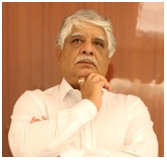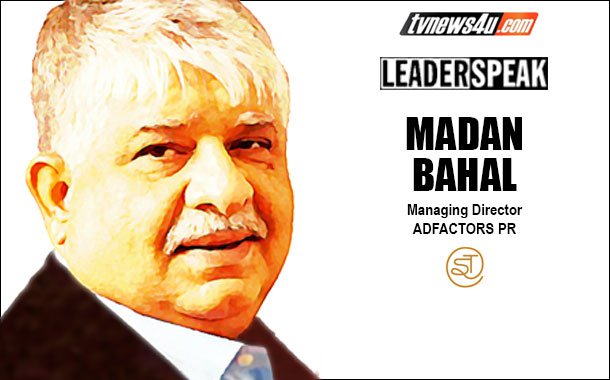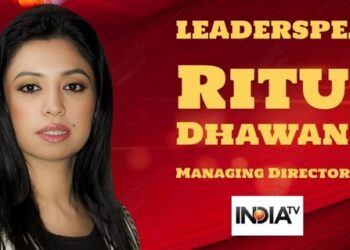He is unarguably one of India’s most respected and leading communication strategists in corporate, financial, consumer and crisis communication. As co-founder and MD of Adfactors PR, which is India’s biggest — and most awarded — PR agency, Madan Bahal is an extremely busy professional. Yet, he always tries and manages to find quality time to meet and interact with young professionals in the making, the students of communication across some of India’s top institutes, on important topics and issues pertaining to the field he loves and has made a name for himself and India in: Strategic communications. In fact, respected creative head and brand guru Kiran Khalap (twitter.com/@KiranKhalap) probably echoed industry sentiment when he tweeted: If Indian PR has to go anywhere, we need at least 10 like him.
One recent address by Bahal was on the subject of reinventing public relations. Though he was addressing students, his speech was in fact a seminal document for communication professionals on this critically important priority. Over to Madan Bahal.
Read on– [email protected]
Reinventing Public Relations
A lot has already been written and spoken on this subject. The idea is not new. It might be therefore useful to explore if we can add some dimensions to this ongoing worldwide discourse.
One must look at the issue from the standpoint of all key constituents:
- The PR firm
- The clients who buy our services
- Individual professionals within firms and the corporate communications function
- The supporting ecosystem – including the PR education system – and students aspiring to build a career in this knowledge profession
We must determine the urgency to assess the pace of needed change, and talk about what needs to change. Why, how and how fast. Last, but not least, we must articulate the rewards and risks
If Indian PR has to go anywhere, we need at least 10 like him
A compelling case for reinvention
Even a cursory glance makes a compelling, urgent case for reinventing the PR industry. We can build the case from pointers that come from multiple sources. Some useful pointers are:
- The performance of the PR industry
- The collective feedback of clients
- Macro-factors influencing our business and
- The sweeping changes happening in the Indian society.
We can get other pointers from:
- The changing structure of the media
- Changing dynamics of influence
- The unprecedented scrutiny of — and chorus for — better governance and accountability from businesses, government and institutions that deliver services and goods to the public
The context and framework
I would like to set the context for reinventing PR in some detail, and lay the framework for looking at my own contentions and for what follows in the subsequent panel discussions.
Let us start with the big picture outlook, move to the prevailing situation at the firms, review some of the barriers that have to be overcome, and how we as individuals will have to respond. Finally, I’d like to share my thoughts on the role, academia and students can play in reinventing PR.
The big picture outlook
We are a nation of 1.3 billion people, with GDP growth averaging more than 7% over the last decade. Soon, India will be a two trillion dollar economy. We are still in the early stages of the developmental cycle, and should grow at a sustained pace for another 20 years.
A 1% increase in GDP growth generates twice that growth in demand for services. The same should be true for public relations – even more so given the unmatched diversity and complexity of our country. Add a tsunami of entrepreneurship; every entrepreneur has a 10X growth dream.
The startup capital to the world needs PR services that could translate into promising 25-30% industry growth for years to come.
The 10X growth dream v/s talent supply constraints

The only constraint is the right capacity on the supply side. If every student about to graduate from a leading institute of academic and professional studies were to start a PR firm, s/he should be able to build a million dollar business within 3-4 years. I can assure you that running a PR firm is not rocket science if you have an open mind and work hard.
However, the current size of the Indian PR industry juxtaposed against the opportunity presents a stark contradiction. In a nearly $2 trillion economy, with all its complexities, Indian PR industry’s annual revenues are just $200 million – one hundredth of one per cent; a small figure indeed.
Influence management and the changing dynamics of influence
Since PR is about influence management, it might be a good idea to see how the dynamics of influence are changing in society. The changing structure of media ownerships driven by corporatisation and the consolidation of large chunks of influential media within corporate houses is a new dimension. Paid content as news is another growing trend. Inspired content on television – and through the powerful medium of Bollywood films – is also influencing Indian society in subtle ways. Powerful new icons of influence include communication-savvy activists and NGOs across the socio-economic political spectrum.
New speed and power to influencing public opinion
The rapid growth of ‘digital’ India demands reinventing PR. Internet access will reach half a billion in the next 2-3 years. The ubiquitous mobile phone will cross a billion connections by the dawn of 2016, making it a connected society with a new speed and power to influencing public opinion. The empowerment of the common man has created millions of citizen journalists who now have a voice that cannot be ignored.
The Modi government’s vision of transforming India in to a digitally empowered society and a knowledge economy must be factored into our work. Imagine an India feeling the impact of universal phone connectivity, broadband in three lakh villages, Wi-Fi in all schools and universities, public cloud and a smartphone in every hand. All this in the next five years, which makes the case for reinventing PR even more urgent.
Great watchdog initiatives
As PR practitioners, we should also be aware of other changes. Our watchdog institutions have strengthened our democratic foundations. Powerful regulators, the election commission, the higher courts and the media have played a wonderful role in enforcing accountability and providing robust checks and balances. The corruption of moral turpitude is under check for the first time in decades, though the corruption of economic necessity will take a lot more time to deal with.
Scrutiny of businesses, politicians and government is unprecedented. It seems you now cannot do anything wrong and get away with it. A very broad front of activism – from customers, shareholders, communities, unions, environmentalists and social activists demanding a corruption-free India, accountability and good governance – is changing the rules of business.
This unnerving pace of change – in government and in society – is multiplying uncertainty and complexity. There is ever-increasing conflict, and the corporation is at the cross-roads of this conflict. CEOs are having sleepless nights and probably spend half their time in dealing with the complexities of the business environment.
PR consultancy industry in stress
From the standpoint of the firm, the PR consultancy business as an industry is in stress, to put it mildly.
- Most leading firms have suffered performance pressure in recent years.
- Revenues are flat or diminishing, margins declining.
- We are unable to pass on service cost inflation that we experience every year.
- There is a high level of staff attrition and a fair degree of client attrition.
Clearly, something is amiss at the PR firms.
What clients want and need
In survey after survey, clients insist on ‘strategic’ counsel; they want more proactive thinking and innovation, high-quality content and campaigns for a convergent world. They would also like to be alerted in advance about impending risks and threats. Lastly, they expect omnipresent engagement capability from the PR firm that can deal with disruptive stakeholders, 24/7. If that wasn’t enough, clients also want wide media delivery and strategic reach for their PR messages.
Re-invent or perish
Who will these CEOs turn to for solace and counsel to help them navigate the storms? Not the McKinseys, BCGs or Bains of the world, or the E&Ys or KPMGs for that matter. The advertising world never even pretended to offer a solution. The cross must be borne by the PR profession globally — whether in-house or the consultancy. This can be PR’s hour of glory, but to succeed in this challenge, PR must reinvent itself. Those of us who do, as firms or individuals, will reap the rewards, while those who don’t will be relegated to marginal survival at best.
The big questions
The obvious questions are: who must reinvent? What do we reinvent? How do we reinvent? What is the time-frame? What will be the cost of reinvention, and what price will we pay for not reinventing?
These are not new issues. Leaders in the PR consulting profession, client organisations and the PR academia have been seized with this for some time now.
Quite a lot has already been said and there is a high level of convergence of views. If you are following the discourse, the propositions are well known. Most of the wisdom on reinvention is only a Google search away. A couple of hours spent on industry platforms like the Holmes Report, PRWeek, the Page Society, PR Daily, and blogs of eminent practitioners like Richard Edelman, Adam Singer and Mark Ragan will empower you with a summary of key issues and priorities for change.
Paul Holmes, the founder and publisher of the Holmes Report, recently wrote about the change agenda for the PR firms in a popular article, “10 ways to design the PR agency of the future”. The ten ideas he listed included:
- Big data at the centre
- Insights to drive meaningful creativity
- Understanding the human brain
- Going beyond communications in managing reputation
- Becoming real brand journalists
- Being truly channel neutral
- Eliminating internal barriers
- Recruiting differently
- Creating new career paths
- Make it matter
Viewpoints of other influential commentators converge around these ideas.
A CCO within a client organization
Let’s examine the role of a Chief Communications Officer (CCO) within the client organisation – which is also under pressure to reinvent. Again, there has been a fair amount of discussion on the evolution of the CCO.
The focus for CCOs include coping with the new media environment, helping the CEO and Board manage the risk environment, becoming the conscience keeper to the corporation, responding to the blurring of lines between corporate and marketing communications, being alert 24/7 to any reputation risks and becoming the filter through which all corporate actions are evaluated for risks before they are initiated.
The CCO will have to articulate and evangelise the purpose of the company and help the company align its behaviour to societal expectations. In a world characterized by trust deficit, the CCO will lead the conversation and actions, imparting greater authenticity to his company’s thinking and actions. He will have to be an ideologue, strategist and action hero: a Krishna, Sanjaya and Arjuna all rolled into one.
In September of 2015, the Arthur W. Page Society — perhaps the most influential thought leader platform for CCOs — dedicated its annual convention in Chicago to discuss just this. The convention theme – The gathering storm: Global forces transforming the role of CCO – highlights the gravity of the reinvention agenda. The urgency to reinvent is in no doubt.
What’s hampering reinvention?
With such a strong case for reinventing PR why are we struggling? What are the barriers that stop us? What is slowing down the reinvention process? Are the barriers internal or external? Do we have pragmatic solutions to expedite the process? I would like to offer some views based on 18 years of experience as a practitioner.
Quality of leadership
Is the quality of industry leadership a barrier? Any significant change process requires leadership that understands the need, intensity and direction of change. More importantly it has to have the resolve, incentive and empowerment to initiate and execute change. It is my humble belief – harsh as it might sound – that the PR industry in India is facing a crisis of leadership. I would like to submit that to reinvent PR we need to reinvent the leadership. Some of us are a bit too outdated or lack the will or the resources to implement reinvention in a reasonable time frame.
The PR firm’s remuneration model
The second barrier to reinvention in my view is the remuneration model of the PR firm in India. Reinventing PR needs high-quality professionals, to retrain and re-skill its existing workforce, investments in knowledge tools, technology, analytics, and planning and engagement capabilities to deliver a new quality of counsel and execution. This requires financial investments, and that is where the paradox lies.
I would like to submit that reinvention at the PR firm is constrained by a struggle for survival. Flat revenues, declining margins, unfixed volumes of work at fixed retainers, ever growing demands and expectations from clients, but without the commensurate remuneration, is putting the PR consulting firm into a tight corner. Call it client myopia if you will. Clients want us to think, but don’t want to pay for it. Pricing is largely based on operational execution. How many clients are willing to pay separately for ideation and strategic thinking?
Yes, clients acknowledge that reputation is a great competitive differentiator, but few are willing to make the right investments. This is unviable. Strategic thinking and counsel require senior resources who come at a higher price, which clients will have to pay for. We need clients to understand and appreciate this contradiction.
This is also borne out by a recent survey conducted by my colleague Vikram Kharvi among corp. comm professionals. Nearly 80% were unwilling to consider a fee hike for their PR firm this year. We must remember that the minimum annual service cost inflation is of the order of 12-14% if you have to attract and retain talent in a talent-starved industry. In every sector, businesses are able to pass on the cost increases to the consumers or clients, but this isn’t happening in PR. We need to reinvent the remuneration model — move from fixed retainers to a mixed model of retainers plus hourly rates for excess work beyond the budgeted time or activities. This is common in mature PR markets in the West and Asia-Pac.
The culture barrier
The third barrier to reinvention that I want to underscore here is a cultural one, and somewhat unique to Indian society. Harsh as it may sound, one could say Indians are shy of cutting-edge thinking, innovation and aiming for the best. We simply do not like to excel and lead the way for others. I say this is a culture issue, based on the evidence of many contradictions of modern India, in diverse fields including science, technology, education, industry or even sports.
Let me cite a few examples:
- A nation with the largest scientific and technical workforce has not won a single Nobel prize for science & technology in the last 85 years. The last Nobel to a resident Indian in science went to CV Raman in the year 1930 for his work on light refraction.
- Or take education. The land of ancient centres of learning like Nalanda and Takshila which attracted scholars from all over the world, does not have a single university that figures in top 200 institutions of higher learning in the world today. The top-placed Indian institution is at 222 in the world — IIT- Bombay.
- Innovation in our knowledge industries is no better – The largest software services provider to the world does not have a single software product to its credit; the pharma-generics power house of the world cannot claim to have created a single research-based molecule.
So you can’t blame the PR practitioner for not reinventing quickly – there seems to be a gene missing in the Indian DNA.
Reinvent and upgrade
For an industry to reinvent, its individual constituents must reinvent themselves. In my personal experience this seems a big barrier. Ninety-eight out of 100 experienced professionals I have interviewed had not read a single book on PR since they joined the profession. Training programs are treated as burdens and there is a general unwillingness to acquire fresh knowledge. A robust theoretical foundation is missing amongst PR practitioners, quite unlike any other knowledge profession be it medicine, law, or closer to us, even marketing and advertising. Many of us have become slaves of standard templates and quick-fix solutions.
The evolved professional should not be limited by the idea of communications – which by definition itself is limiting. One school of thought says that public relations is 90% behaviour and 10% communications. Our jobs will involve advising client corporations on the right conduct in society so that they are not mis-aligned with stakeholder expectations. This in my opinion will drive the strategic relevance of PR professionals.
What’s PR’s social mission?
There’s one more thing. This intrigues me all the time. We do not have a commonly understood social mission for the PR profession. Each profession has a larger social purpose, and practitioners at a global level have a common understanding of what their relevance is to the society at large.
Any doctor or nurse will say that their social mission is to safeguard the larger health of society. A police man protects people by enforcing law and order; a journalist creates an informed society. Ask 100 PR professionals on what is their role and relevance to society and you might get 100 different answers.
There is no common definition of PR as to its purpose. No book, no trade body nor any ideologue has tried to address this dilemma. In my opinion, a crowd-sourced definition of PR in the US, initiated by the American PR Agencies Association, took the definition of PR back 70-80 years – to the days of Edward Bernays, the father of modern public relations.
Which brings me to another important idea.
Reinventing PR education
The time for reinventing PR education, in light of the roles that academia and students will play, is well and truly here.
There must be a sincere effort to train aspiring PR professionals in the skills required today, and to cover a wide range of contemporary subjects – from research to analytics and CRM, from digital communications to Public affairs and rural marketing to CSR.
Additionally, one might argue for greater emphasis in a few areas – like understanding of business strategy, change management and change communications, digital tools and techniques and opinion research, plus in the area of building collaborative teams.
I would also recommend that each student passing the portals of her or his institute read at least 500 global case studies in PR before stepping into the real world.
Re-skill, re-train
We have a large body of well-meaning professionals who need to be re-skilled and re-trained, both in the agency and the comms function. Inaction will lead to many a career collapsing in the near future. Leading PR institutions should recognise the opportunity and quickly develop executive education modules.
In any professional services sector, the consulting arm and the academia are the fountainhead of change ideas. For example, most of the contemporary management concepts were born in a McKinsey, BCG, Harvard or Stanford. The responsibility of reinvention of PR must principally rest on the shoulders of the consulting profession and the academic institutions. The demand side of the business must bear the responsibility of facilitating the change.
Let me quickly dwell on internships. It would be useful to do internships in allied areas – like market research firms, digital production units, reporting bureaus in mainstream media, think tanks and meaningful NGOs. Internship in the PR firm is not so critical; students are going to spend a long time in PR firm or a comms function anyway.
My wish-list has a few more points. The post-grad in PR needs to have a reasonable understanding of the Indian society, its diversity and complexity – of its social, cultural, political, legal and administrative structure. Young professionals should comprehend the sweeping changes happening in the Indian society even as we speak. Though I saw a module called ‘the Indian kaleidoscope’ in semester one, this might not be enough. To this extent, the PR educations should draw inspiration from the IAS.
The power of philosophy and faith
An understanding of Indian philosophical systems is necessary too for a sound practice in India for they have a profound influence on day-to-day life. A basic introduction to schools of philosophy like Nyaya, Yoga, Vaisheshika, Samkhya, MJmamsa and Vedanta is recommended. Gandhiji influenced and moved an entire Indian society to action by focusing on a single starting tenet of all schools of Indian philosophy namely, Ahimsa. As we all know Ahimsa became the guiding principle in the fight to acquire freedom. Such is the power of philosophy and faith in Indian life.
Our work is about resolving conflict, creating a dialogue, making diverse stake holders engage with each other. It’s an arbitration role which requires the arbitrator to have a certain level of social skill and emotional intelligence. We need to relearn the lost arts of listening, humility, empathy, sensitivity and compassion. An arbitrator must be inherently trustworthy to facilitate a dialogue. It might be good idea to include some chapters from the moral science book of primary education.
Reinventing PR will have to be a collaborative effort between all its constituents – PR firms, clients, supporting ecosystem, educational institutions. We need an ongoing dialogue on the pain-points, expectations and aspirations of each constituency moderated by a pragmatic approach to disruption. We need to define what PR reinvention means for the Indian context and what should be our priorities.

















